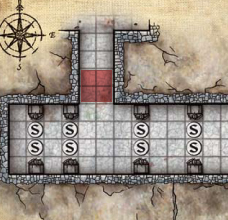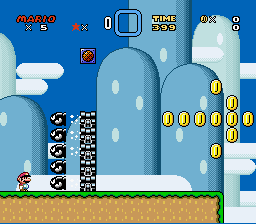In my continued efforts to provide you with only the finest fodder for utterly crushing your players, I bring you another guest post from one of the best trap aficionados in the D&D community – Sersa V.
In case you haven’t heard of him he runs a blog that specializes in hardcore encounters for 4e, put best in his own words: “D&D hardcore – exceedingly lethal dungeon challenges for the D&D 4th Edition game” also known as ‘4thcore’. The sheer amount of content and the quality within is a rarity, so if you haven’t checked his out yet I highly suggest you do so.
The trap outlined below is not for the faint of heart and is definitely a good way to start (or end) an encounter with a bang. It may even force some of those more passive players to think twice before hanging around inside dungeon foyers like a bump on a log while their fellow party members advance boldly. Not that there’s anything wrong with hanging back but it’ll definitely keep em’ on their toes after encountering one of these. I’ll definitely be using it when kicking off my new campaign tonight.
In the coming weeks I should be outlining my campaigns progress via Obsidian Portal. I’ll also be doing a follow up post or two here to let you know how my newfound anti “care bear” DM’ing style is going. Will I be able to fight my hand holding tendencies and maybe actually kill someone this time around should the situation arise? Will I stop fudging so many die rolls? I certainly hope so.
Without further adieu, the trap:
Kaizo Traps in D&D (Part 1)
Written by Sersa V (aka @SaveVersusDeath)
As deadly Dungeon Masters, we must always improve the craft of challenging players by seeking innovation in the art of deception and slaughter. Truly great and fearsome DMs – those about which rumors and legends circulate – excel in that they look beyond the tabletop genre for inspiration in the art of trickery. One such source – infamous for its difficulty and creative traps – is a modification of Super Mario World known as Kaizo Mario.
Kaizo Mario is a Platform Hell game in the rich tradition of The Life-Ending Adventure and I Wanna Be the Guy. As the game is described on the unofficial Kaizo Mario website:
“Kaizo Mario is a rom hack of Super Mario World created by T. Takemoto, an unknown Japanese rom hacker. It was made to split your eyes out and make you cry. The game includes difficult, precision jumps; multiple obstacles at once; and many, many nasty traps along the way.”
Kaizo Mario has become synonymous with a number of traps and tricks now common in fan-created Platform Hell hacks. This article series will focus on how you might adapt two of the most notable for D&D 4th Edition: the level start trap (Part 1) and the level goal trap, or, the original ‘Kaizo Trap’ (Part 2).
Level Start Traps
Kaizo Mario is notorious for traps that kill you at the very beginning of a level unless you act immediately. Typically, this involves jumping over or around Bullets, evading monsters, or ducking away from Thwomps.
- Example 1
- Example 2
- Example 3 This trap is the inspiration for the sample trap featured in this article.
The sample trap in this category, the delayed entrance-sealing deadfall, is placed in the last squares of a hallway leading into a dungeon chamber. Dungeon denizens prefer to operate the trap manually from a safe distance, allowing them to raise the block once all of the intruders have been driven away (and preventing thieves from disabling it). While the trap is triggered on the first round of an encounter, it takes no action on its first turn. Ideally, this trap catches those who refused to move into the encounter area during their first turn.
Alternatively, and perhaps much more sinister, a trigger such as a pressure plate can be laid 5 or more squares into the chamber. If this trigger is used, the trap does not roll initiative or wait a turn when sprung – it attacks immediately, crushing those who stood in the entrance to watch while others moved forward.

Delayed Entrance-Sealing Deadfall
Level Variable Minion Trap (XP Variable) | Object
Detect Dungeoneering (hard) or Perception (hard + 2) Initiative +2 plus one-half level
Immune attacks
STANDARD ACTIONS
Attack * Encounter
Attack: Melee (creatures in a 2-by-2 square area); Level + 1 vs. Reflex
Hit: Limited damage by level, and the target is dazed, immobilized, knocked prone and takes ongoing 15 damage per tier (save ends all). Second Failed Save: The target is crushed and dies.
Miss: The target shifts into a safe space of their choice adjacent to the trap.
Effect: Squares in the trap’s area of effect block movement, line of sight, and line of effect until the deadfall is raised.
COUNTERMEASURES
Brace: Athletics (hard). Success: The trap cannot activate until the start of character’s next turn. If the character moves, the trap immediately attacks (if triggered). Failure: If the trap was triggered, it immediately attacks. The character that failed the check grants combat advantage to the trap.
Lift: Athletics (hard + 2). Success An adjacent character lifts the deadfall. The character must make a new check as a standard action at the start of each subsequent turn or drop the block.
Raise: No check required. A character adjacent to the mechanism that controls the trap can switch it with a minor action. This mechanism is almost always 10 or more squares away from the trap.
UPGRADE TO STANDARD (STANDARD XP)
* The trap gains the following at-will attack, which it may only use after it has triggered. It fires into the room. An adjacent character can disable the jet with a standard action and a Thievery check (hard).
Jet (variable) * At-Will
Attack: Close blast 3 (creatures in blast); Level + 3 vs. Reflex
Hit: Acid, cold, or fire damage by level, and ongoing 5 acid, cold, or fire damage per tier (save ends).
Miss: 2 acid, cold, or fire damage per tier.
* The trap mechanism now requires a Thievery check (moderate) to operate.




Pingback: Kaizo Traps in D&D 4E (Part 1) « Save Versus Death
Pingback: Weekly Roundup – Spoooooky Edition | Roving Band of Misfits